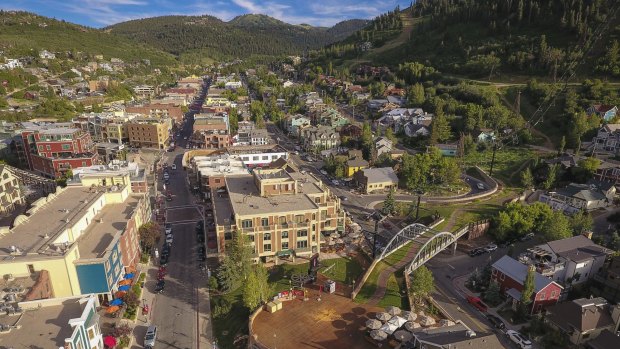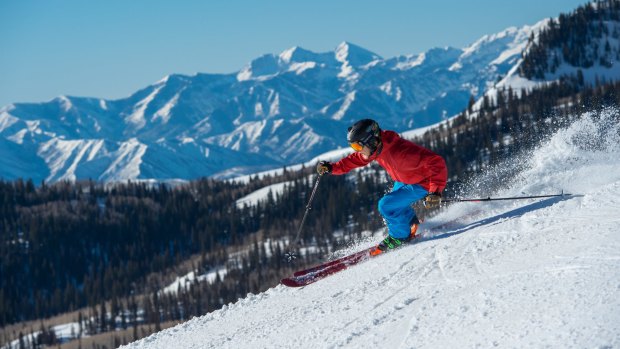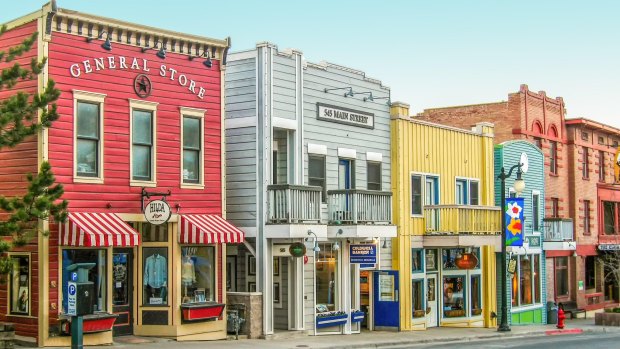This was published 5 years ago
Park City history, Utah, US: How a Wild West ghost town became a ski hotspot

Park City nearly became a ghost town before reinventing itself as a ski destination.Credit: Marc Piscotty
We meet at the top of Motherlode Express for one of the world's oddest heritage tours. The Silver to Slopes historic mining tour entails skiing intermediate blue while learning about the silver-mining industry that gave Park City its nickname – Treasure Mountain.
"Twenty-two millionaires made their fortunes here," says our guide, Tom Coleman. "Silver built this city."
Take Utah's "Silver Queen", the socialite Susanna Bransford, known for her four husbands, her mansions, her fashion sense and extravagant parties. What's forgotten is that Bransford was a well-connected, self-made businesswoman ahead of her time.

Skiing is popular in Park City, but there's more than the slopes on offer.
Coleman's favourite miner-made-good is Thomas Kearns: "He arrived penniless in 1883. Seven years later Kearns was a millionaire. In 1900, he was elected US senator. His home in Salt Lake City is now the Utah governor's mansion."
Utah and Salt Lake City were founded by Mormons – led by the charismatic Brigham Young – who were trekking west to escape religious persecution. Even today, 40 per cent of "Utahns" are Mormons.
Park City, however, was never Mormon. Native Americans also had too much sense to camp in the snow-deluged Wasatch range, at the western edge of the Rockies. Miners, however, to paraphrase President John F. Kennedy, were willing to "pay any price, bear any burden, meet any hardship" and gamble their lives for the possibility of a lucky strike.

Park City was originally built on the back of a silver boom.Credit: Alamy
Before America's transcontinental railway was completed there were two ways for miners to get to the Californian gold rush of 1849: the southern "Mormon" route or the northern "Oregon Trail". Those who had endured the dangerous wagon train as far west as the Great Salt Lake were tempted to stay. Why risk travelling to California when there was "silver in them thar hills" above Park City?
In 1869, however, everything changed, says Coleman. The two railways that had been spreading west from New York and east from Los Angeles were finally connected, and the ceremonial "golden spike" to mark the achievement was driven in at Promontory Summit, 180 kilometres north of Park City. Suddenly, Utah was no longer the remote sanctuary Mormons had envisaged and mine owners had access to two invaluable assets: cheap labour (mainly Chinese) and experienced engineers.
"The mine owners hired out-of-work railway engineers to build an aerial tramway," Coleman explains. "Before that, horse-drawn wagons carried the silver ore down the mountain. Overhead buckets allowed the ore to be transported however deep the snow. Our silver ore was never especially rich, but mining technology and the railway made it cheap when it got to market."
The most fascinating is Thaynes Mine hoist house – all that remains of the elaborate subterranean system of vertical mine cage and hand-built tunnels that took the ore from the mine to Park City.
The system was used as a "skier subway" for five years from 1964. Skiers were carted in mine trolleys deep into the mountain and then ascended the flimsy miner's cage to begin skiing.
By 1955, the mining boom had bust. Park City – a Wild West town with more brothels than churches, more stables than schools – had shrunk from a population of 20,000 to 700.
On the verge of being declared a ghost town, it was rescued when Utah politicians and business people went to petition Kennedy, in 1963, shortly before he was assassinated.
"What can I do for Utah?" JFK asked. By the time they left the White House, funds had been secured to turn Park City into a ski resort.
You don't need to ski or even like snow to enjoy Park City's heritage. In summer, it becomes a hub for cycling, mountain biking, canoeing, trekking and fishing.
Its museum – the former police and fire station which, aptly, survived the great fire of 1898 – is worth an hour of any visitor's time. The rebuilt Main Street – complete with a brewery, two distilleries, fancy restaurants, galleries and the Egyptian Theatre, which hosts some of the premiere movies of each year's Sundance Film Festival – is a hilly adventure in itself.
Mine it while you can.
TRIP NOTES
Steve Meacham was a guest of Park City Chamber of Commerce.
MORE
FLY
Delta flies from Los Angeles to Salt Lake City return several times daily. See delta.com
STAY
Park City Peaks hotel has a good family-friendly restaurant, Versante, plus an all-weather swimming pool/hot tub and a regular shuttle to the ski slopes and Main Street. See parkcitypeaks.com
TOUR
The two-hour Silver to Slopes tour is free to holders of a valid Park City lift pass. See parkcitymountain.com
Sign up for the Traveller Deals newsletter
Get exclusive travel deals delivered straight to your inbox. Sign up now.